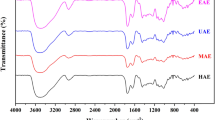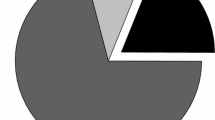Abstract
Pearl powder has been used in medicine and beauty treatment since ancient times in China. However, it is still unclear whether the biological activities of pearl powder are affected by different extraction methods or not. In this study, we determine the total protein yield, protein molecular weight and biological activities including antioxidant, tyrosinase inhibition and melanogenesis inhibition activities and cytotoxicity of different pearl powder extracts prepared by five different preparation methods. The ultrasonic-assisted extraction (UAE) and microwave-assisted extraction (MAE) of pearl powder were optimized by the response surface method based on total protein yield. Compared with solid-liquid extraction (SLE), the optimized UAE and MAE increased the total protein yield without changing protein molecular weight. In addition, the extract by MAE enhanced the tyrosinase inhibition activity and anti-melanogenesis activity slightly. Acidolysis hydrolyzes macromolecular protein into small molecules with obvious cytotoxicity and low activities. Enzymolysis can hydrolyze macromolecular protein into small molecules with high protein yield and improvement of bioactivities. In the determination of the antioxidant assay, the extract prepared by the enzymolysis showed significant activity. These results suggest that protein molecules of the pearl powder extract are degraded appropriately by enzymolysis to smaller molecules to obtain the enhanced biological activities that can be applied in the cosmetic industry.






Similar content being viewed by others
Data Availability
Considered upon request. Further information is available from the corresponding author on reasonable request.
Code Availability
Not applicable.
References
Iwuozor KO, Emmanuel SS, Ahmed MO, Idris AM, Emenike EC, Saliu OD, Qudus AH, Adeniyi AG (2023) Technologies for the extraction and post-extraction of Stevia rebaudiana leaves. Chem Afr. https://doi.org/10.1007/s42250-023-00787-0
Huang M, Lu JJ, Ding J (2021) Natural products in Cancer Therapy: past, Present and Future. Nat Prod Bioprospect 11:5–13. https://doi.org/10.1007/s13659-020-00293-7
Owen AE, Louis H, Ejiofor EU, Emori W, Gber TE, Benjamin I, Cheng C-R, Orosun MM, Ling L, Adeyinka AS (2023) Natural andrographolide isolated from Andrographis paniculata as Potent Epileptic Agent: Spectroscopy, Molecular structure, and Molecular Docking Investigation. Chem Afr 6:2445–2461. https://doi.org/10.1007/s42250-023-00657-9
Pei JY, Wang Y, Zou XG, Ruan HJ, Tang CM, Liao J, Si GJ, Sun PL (2021) Extraction, purification, Bioactivities and Application of Matrix proteins from Pearl Powder and Nacre Powder: a review. Front Bioeng Biotechnol 9:649665. https://doi.org/10.3389/fbioe.2021.649665
Yotsuya Y, Hasegawa Y (2022) Nacre extract from pearl oyster attenuates amyloid beta-induced memory impairment. J Nat Med 76:419–434. https://doi.org/10.1007/s11418-021-01598-8
Loh XJ, Young DJ, Guo H, Tang L, Wu Y, Zhang G, Tang C, Ruan H (2021) Pearl Powder-An Emerging Material for Biomedical Applications: a review. Mater (Basel) 14:2797. https://doi.org/10.3390/ma14112797
Xia M, Huang DL, Tong YM, Lin J (2020) Pearl powder reduces sleep disturbance stress response through regulating proteomics in a rat model of sleep deprivation. J Cell Mol Med 24:4956–4966. https://doi.org/10.1111/jcmm.15095
Yang S, Wang ZK, Hu YW, Zong KL, Zhang XJ, Ke H, Wang P, Go YY, Chan XHF, Wu JX, Huang Q (2023) Hydrolyzed conchiolin protein (HCP) extracted from Pearls antagonizes both ET-1 and α-MSH for skin whitening. Int J Mol Sci 24:7471. https://doi.org/10.3390/ijms24087471
Song YL, Chen WY, Fu K, Wang Z (2022) The application of pearls in Traditional Medicine of China and their chemical constituents, Pharmacology, Toxicology, and Clinical Research. Front Pharmacol 13:893229. https://doi.org/10.3389/fphar.2022.893229
Albuquerque BR, Pinela J, Barros L, Oliveira M, Ferreira I (2020) Anthocyanin-rich extract of jabuticaba epicarp as a natural colorant: optimization of heat- and ultrasound-assisted extractions and application in a bakery product. Food Chem 316:126364. https://doi.org/10.1016/j.foodchem.2020.126364
Guo HL, He TY, Lee DJ (2022) Contemporary proteomic research on lignocellulosic enzymes and enzymolysis: a review. Bioresour Technol 344:126263. https://doi.org/10.1016/j.biortech.2021.126263
Boffo EF, de Melo KS, Shiromoto MO, Silva AD, Vieira PC, Ambrozin ARP (2022) Chemometrics applied to (1)H NMR and UV-Vis spectroscopy as a way to evaluate solid-liquid extraction of leaves of artichoke. Food Chem 377:131979. https://doi.org/10.1016/j.foodchem.2021.131979
Mahboubi M (2019) Caraway as important Medicinal plants in Management of diseases. Nat Prod Bioprospect 9:1–11. https://doi.org/10.1007/s13659-018-0190-x
Vardanega R, Cerezal-Mezquita P, Veggi PC (2022) Supercritical fluid extraction of astaxanthin-rich extracts from Haematococcus pluvialis: economic assessment. Bioresour Technol 361:127706. https://doi.org/10.1016/j.biortech.2022.127706
Torres MD, Flórez-Fernández N, Dominguez H (2021) Ultrasound-assisted water extraction of Mastocarpus Stellatus Carrageenan with adequate mechanical and Antiproliferative Properties. Mar Drugs 19:280. https://doi.org/10.3390/md19050280
Echave J, Fraga-Corral M, Garcia-Perez P, Popović-Djordjević J, E HA, Radulović M, Xiao J, Simal-Gandara MAP J (2021) Seaweed protein hydrolysates and bioactive peptides: extraction, purification, and applications. Mar Drugs 19:500. https://doi.org/10.3390/md19090500
Linares G, Rojas ML (2022) Ultrasound-assisted extraction of natural pigments from Food Processing By-Products: a review. Front Nutr 9:891462. https://doi.org/10.3389/fnut.2022.891462
Zhang YL, Lei Y, Qi SR, Fan MX, Zheng SY, Huang QB, Lu X (2023) Ultrasonic-microwave-assisted extraction for enhancing antioxidant activity of Dictyophora indusiata polysaccharides: the difference mechanisms between single and combined assisted extraction. Ultrason Sonochem 95:106356. https://doi.org/10.1016/j.ultsonch.2023.106356
Arya P, Kumar P (2021) Comparison of ultrasound and microwave assisted extraction of diosgenin from Trigonella foenum graceum seed. Ultrason Sonochem 74:105572. https://doi.org/10.1016/j.ultsonch.2021.105572
Hueso D, Fontecha J, Gómez-Cortés P (2022) Comparative study of the most commonly used methods for total protein determination in milk of different species and their ultrafiltration products. Front Nutr 9:925565. https://doi.org/10.3389/fnut.2022.925565
Karimi F, Hamidian Y, Behrouzifar F, Mostafazadeh R, Ghorbani-HasanSaraei A, Alizadeh M, Mortazavi SM, Janbazi M, Naderi Asrami P (2022) An applicable method for extraction of whole seeds protein and its determination through Bradford’s method. Food Chem Toxicol 164:113053. https://doi.org/10.1016/j.fct.2022.113053
Wiesner R, Scheller C, Krebs F, Wätzig H, Oltmann-Norden I (2021) A comparative study of CE-SDS, SDS-PAGE, and simple western: influences of sample preparation on molecular weight determination of proteins. Electrophoresis 42:206–218. https://doi.org/10.1002/elps.202000199
Guo HK, Guo SY, Liu HM (2020) Antioxidant activity and inhibition of ultraviolet radiation-induced skin damage of selenium-rich peptide fraction from selenium-rich yeast protein hydrolysate. Bioorg Chem 105:104431. https://doi.org/10.1016/j.bioorg.2020.104431
Chen Y, Zheng ZJ, Ai ZX, Zhang Y, Tan CP, Liu YF (2022) Exploring the antioxidant and Structural Properties of Black Bean Protein Hydrolysate and its peptide fractions. Front Nutr 9:884537. https://doi.org/10.3389/fnut.2022.884537
Bueno-Gavilá E, Abellán A, Girón-Rodríguez F, Cayuela JM, Tejada L (2021) Bioactivity of Hydrolysates obtained from Chicken Egg Ovalbumin using Artichoke (Cynara scolymus L.) proteases. Foods 10:246. https://doi.org/10.3390/foods10020246
Song YQ, Chen SJ, Li LH, Zeng YX, Hu X (2022) The Hypopigmentation mechanism of tyrosinase inhibitory peptides derived from Food proteins: an overview. Molecules 27:2710. https://doi.org/10.3390/molecules27092710
Chen J, Zhang ZW, Li HH, Tang HJ (2023) Exploring the effect of a series of flavonoids on tyrosinase using integrated enzyme kinetics, multispectroscopic, and molecular modelling analyses. Int J Biol Macromol 252:126451. https://doi.org/10.1016/j.ijbiomac.2023.126451
Jakimiuk K, Sari S, Milewski R, Supuran CT, Şöhretoğlu D, Tomczyk M (2022) Flavonoids as tyrosinase inhibitors in in silico and in vitro models: basic framework of SAR using a statistical modelling approach. J Enzyme Inhib Med Chem 37:427–436. https://doi.org/10.1080/14756366.2021.2014832
Park HJ, Byun KA, Oh S, Kim HM, Chung MS, Son KH, Byun K (2022) The combination of Niacinamide, vitamin C, and PDRN mitigates melanogenesis by modulating Nicotinamide Nucleotide Transhydrogenase. Molecules 27:4923. https://doi.org/10.3390/molecules27154923
Gąsowska-Bajger B, Wojtasek H (2023) Oxidation of baicalein by tyrosinase and by o-quinones. Int J Biol Macromol 231:123317. https://doi.org/10.1016/j.ijbiomac.2023.123317
Zhao W, Yang AQ, Wang J, Huang D, Deng YK, Zhang XL, Qu QL, Ma WJ, Xiong RH, Zhu MM, Huang CB (2022) Potential application of natural bioactive compounds as skin-whitening agents: a review. J Cosmet Dermatol 21:6669–6687. https://doi.org/10.1111/jocd.15437
Funding
This work was supported by funding from the Zhejiang Provincial Natural Science Foundation of China under Grant (LQ23H300008), National Key Research and Development Program of China (2022YFC2804104), China Postdoctoral Science Foundation (2022M712823 and 2023T160582), Key Research and Development Program of Zhejiang (2021C03084).
Author information
Authors and Affiliations
Contributions
W. W., H. W., Q. L. participated in research design. W. W., L. A., J. L., D. L., Z. S. conducted experiments. W. W., J. L., Z. S. performed data analysis. W. W., J. L., Z. S. wrote or contributed to the writing of the manuscript. All authors read and approved the final manuscript.
Corresponding author
Ethics declarations
Consent for Publication
Not applicable.
Consent to Participate
Not applicable.
Competing Interests
Confirm that there are no related financial or non-financial competing interests that need to be declared.
Additional information
Publisher’s Note
Springer Nature remains neutral with regard to jurisdictional claims in published maps and institutional affiliations.
Electronic Supplementary Material
Below is the link to the electronic supplementary material.
Rights and permissions
Springer Nature or its licensor (e.g. a society or other partner) holds exclusive rights to this article under a publishing agreement with the author(s) or other rightsholder(s); author self-archiving of the accepted manuscript version of this article is solely governed by the terms of such publishing agreement and applicable law.
About this article
Cite this article
Wang, W., An, L., Lei, J. et al. Effects of Different Extraction Methods on Biological Activities of Pearl Powder Extracts. Chemistry Africa (2024). https://doi.org/10.1007/s42250-024-00961-y
Received:
Accepted:
Published:
DOI: https://doi.org/10.1007/s42250-024-00961-y




